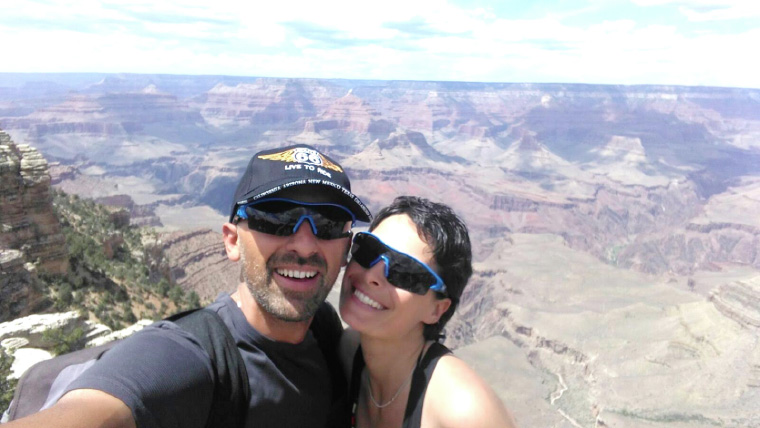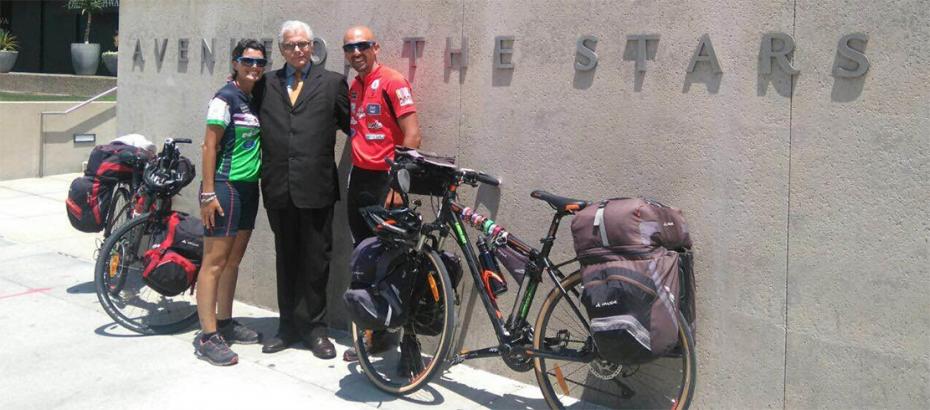In 2014, Giovanna Napolitano e Giuseppe Campochiaro, an Italian young couple, traversed by foot the pilgrimage route to Santiago De Compostela (Galicia, Spain) known as the French Way.
As they were hiking along the mountainous trail, they had a vision. I’m not talking about a heavenly “vision,” like the ones experienced by Saint Padre Pio, who hailed from Pietralcina, a town in the same geographical area.
I’m referring to the couple’s clear vision of their long-term mission, to traverse together six continents over a six-year span, in order to spread the traditions and values of their homeland, historical area of “Samnium” (today corresponding to the Province of Benevento, Campania).
The latter in turn certainly is a pilgrimage destination, visited by flocks of pilgrims eager to see Padre Pio’s “sights,” but also one of the areas in Italy, with the most heart-felt religious devotion.
For instance, Guardia Sanframondi, village in the same Province, every seven years, holds a penitential rite and procession to honor and remember the discovery of a Madonna and Child statue in a field, hundreds of years ago.
After their life-changing pilgrimage to Santiago De Compostela, and their bike ride from their hometown Amorosi (Province of Benevento) to Cape North (Norway), they just completed their last feat by bike, again from Amorosi through the French Way up to Lisbon, and then, after the transatlantic flight, along the historical Route 66, from NYC to L.A.
I had the chance to meet briefly Giovanna e Giuseppe, as they were officially welcomed at their arrival in Los Angeles by Antonio Verde, Consul General of Italy, on July 29.
The Consul commended the feat accomplished by this young couple, who traversed approximately 6213 miles across the old continent and the new world. “Their journey perfectly embodied the intense willpower, the ability to take up a challenge and the eagerness to broaden their horizons, qualities that represent the very best of Italy. In the US, and L.A. in particular, we are not new to such accomplishments, constantly achieved by our fellow Italians through energy, creativity and passion.”

Giuseppe and Giovanna, please tell us how the idea behind Love Wheels was born?
The idea came to us in 2014, as we were traversing by foot the main pilgrimage way from Saint-Jean-Pied-de-Port – on the French side of the Pyrenean range of mountains – to Santiago De Compostela – capital of the autonomous community of Galicia, northwestern Spain. The total route consists of about 900 kilometers (approximately 560 ml).
The “Camino de Santiago” (a.k.a. Way of St. James) represented one of the most preeminent Christian pilgrimages during the medieval period, alongside the ones to Rome and Jerusalem.
Its spiritual significance has never stopped throughout the centuries. We felt we were really growing spiritually, as we reached Spain’s westernmost point overlooking the Atlantic Ocean, “Cape Finisterre” (literally, the “end of the world” in Latin).
Last year, we thought bigger. Traversing the 5500 km (around 3418 ml) route from our hometown Amorosi, province of Benevento, Campania, to Cape North, Norway. The wider distance led us to opt for the bicycles.
Keep in mind that we are both trained in karate, but we are not professional cyclists. That was our first time embarking in such an endeavor.
Unexpectedly, we garnered lots of followers on our Facebook and Instagram pages. That was the official birth of our project “Love Wheels 646,” that is biking across our six continents in six years, trying to connect with the Italian communities spread throughout the globe.
We just completed our last daring enterprise, a bike ride from Amorosi, Italy, again through the French Way to Santiago De Compostela and then to Lisbon, Portugal. After flying across the Atlantic Ocean and landing in NYC, we resumed biking along the historical Route 66 up to L.A.
Our initiative has been receiving the sponsorship from local companies, in our beloved area of Sannio, whose culture, traditions and products we are spreading wherever we go.
What was the most challenging step along the Route 66?
Traversing the desolate landscapes, as you’re surrounded by nothing else than the desert, represented a real challenge. After a while, we felt the impelling desire to reconnect with our fellow human beings.
Our individual sense of loneliness was intensified by the fact that each of us rode at his/her own pace, keeping a certain distance from one another.
The most rewarding moment each time was when, after climbing a hill, we were finally in sight of a city, or some sign of civilization.
Which, among the places you traversed, impressed you the most and why?
With no doubt, Chicago, Illinois. Despite its remarkable size, this city is neatly organized and has a great mobility. That is not to say that it is totally safe, since battles among gangs still occur regularly.
As far as weather’s conditions in the metropolis, properly nicknamed the “Windy City,” we were lucky enough to have not faced headwind.
On the contrary, New York holds its great fascination, but to us, who come from a small village, is too chaotic.
In conclusion, tell us about your most significant encounters you had along your bi-continental route?
In Europe, characterized by a constellation of villages, towns and cities neighboring one another, we made acquaintances with lots of people.
The system of sister cities facilitates the connection among communities across each country’s borders. For instance, Montesarchio, in our Sannio area, is twinned with La Garde, France.
Moreover, we have become worldwide promoters of the global network of places embracing a healthy way of living, called “Cittaslow International” – originated in Orvieto, Umbria, in 1999.
Caiazzo (province of Caserta), in our home region of Sannio, was among the first to acquire such a status.
So far, in the US, only communities in San Francisco and Miami have adopted this “slow” lifestyle, but Cittaslow’s followers are growing throughout the world.






























